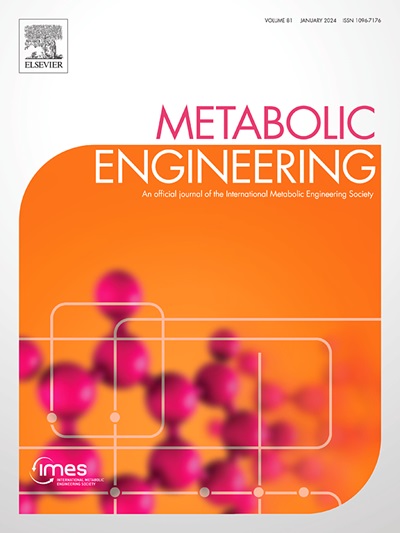α-Substituted 3-hydroxy acid production from glucose in Escherichia coli
IF 6.8
1区 生物学
Q1 BIOTECHNOLOGY & APPLIED MICROBIOLOGY
引用次数: 0
Abstract
Polyhydroxyalkanoates (PHAs) are renewably-derived, microbial polyesters composed of hydroxy acids (HAs). Demand for sustainable plastics alternatives, combined with the unfavorable thermal properties exhibited by some PHAs, motivates the discovery of novel PHA-based materials. Incorporation of α-substituted HAs yields thermostable PHAs; however, the reverse β-oxidation (rBOX) pathway, the canonical pathway for HA production, is unable to produce these monomers because it utilizes thiolases with narrow substrate specificity. Here, we present a thiolase-independent pathway to two α-substituted HAs, 3-hydroxyisobutyric acid (3HIB) and 3-hydroxy-2-methylbutyric acid (3H2MB). This pathway involves the conversion of glucose to various branched acyl-CoAs and ultimately to 3HIB or 3H2MB. As proof of concept, we engineered Escherichia coli for the specific production of 3HIB and 3H2MB from glucose at titers as high as 66 ± 5 mg/L and 290 ± 40 mg/L, respectively. Optimizing this pathway for 3H2MB production via a novel byproduct recycle increased titer by 60%. This work illustrates the utility of novel pathway design HA production leading to PHAs with industrially relevant properties.
大肠杆菌利用葡萄糖生产α-取代的 3-羟基酸。
聚羟基烷酸酯(PHA)是一种可再生的微生物聚酯,由羟基酸(HAs)组成。对可持续塑料替代品的需求,加上某些 PHAs 所表现出的不利热特性,促使人们发现了新型 PHA 基材料。掺入α-取代的HAs可产生耐热的PHA;然而,HA生产的典型途径--反向β-氧化(rBOX)途径却无法生产这些单体,因为它利用的是底物特异性很窄的硫醇酶。在这里,我们提出了一种不依赖硫醇酶的途径来产生两种α-取代的HA,即3-羟基异丁酸(3HIB)和3-羟基-2-甲基丁酸(3H2MB)。这一途径包括将葡萄糖转化为各种支链酰基-CoAs,并最终转化为 3HIB 或 3H2MB。作为概念验证,我们改造了大肠杆菌,以葡萄糖为原料特异性生产 3HIB 和 3H2MB,滴度分别高达 66 ± 5 mg/L 和 290 ± 40 mg/L。通过新型副产品循环优化该途径生产 3H2MB,滴度提高了 60%。这项工作说明了新型途径设计 HA 生产的实用性,从而生产出具有工业相关特性的 PHAs。
本文章由计算机程序翻译,如有差异,请以英文原文为准。
求助全文
约1分钟内获得全文
求助全文
来源期刊

Metabolic engineering
工程技术-生物工程与应用微生物
CiteScore
15.60
自引率
6.00%
发文量
140
审稿时长
44 days
期刊介绍:
Metabolic Engineering (MBE) is a journal that focuses on publishing original research papers on the directed modulation of metabolic pathways for metabolite overproduction or the enhancement of cellular properties. It welcomes papers that describe the engineering of native pathways and the synthesis of heterologous pathways to convert microorganisms into microbial cell factories. The journal covers experimental, computational, and modeling approaches for understanding metabolic pathways and manipulating them through genetic, media, or environmental means. Effective exploration of metabolic pathways necessitates the use of molecular biology and biochemistry methods, as well as engineering techniques for modeling and data analysis. MBE serves as a platform for interdisciplinary research in fields such as biochemistry, molecular biology, applied microbiology, cellular physiology, cellular nutrition in health and disease, and biochemical engineering. The journal publishes various types of papers, including original research papers and review papers. It is indexed and abstracted in databases such as Scopus, Embase, EMBiology, Current Contents - Life Sciences and Clinical Medicine, Science Citation Index, PubMed/Medline, CAS and Biotechnology Citation Index.
 求助内容:
求助内容: 应助结果提醒方式:
应助结果提醒方式:


